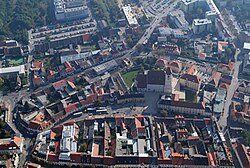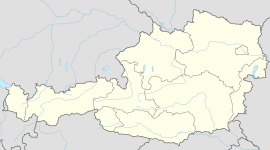Eisenstadt
| Eisenstadt | ||
|---|---|---|
 |
||
|
||
| Location within Austria | ||
| Coordinates: 47°51′N 16°31′E / 47.850°N 16.517°ECoordinates: 47°51′N 16°31′E / 47.850°N 16.517°E | ||
| Country | Austria | |
| State | Burgenland | |
| District | Statutory city | |
| Government | ||
| • Mayor | Andrea Fraunschiel (ÖVP) | |
| Area | ||
| • Total | 42.91 km2 (16.57 sq mi) | |
| Elevation | 182 m (597 ft) | |
| Population (1 January 2016) | ||
| • Total | 14,241 | |
| • Density | 330/km2 (860/sq mi) | |
| Time zone | CET (UTC+1) | |
| • Summer (DST) | CEST (UTC+2) | |
| Postal code | 7000 | |
| Area code | 02682 | |
| Vehicle registration | E | |
| Website | www.eisenstadt.at | |
Eisenstadt (German pronunciation: [ˈaɪ̯zn̩ʃtat]; Hungarian: Kismarton, Croatian: Željezni grad, Željezno, Slovene: Železno) is a city in Austria, the state capital of Burgenland. It has a population of about 14,241 (2016). In the Habsburg monarchy, Kismarton (Eisenstadt) was the seat of the Eszterházy Hungarian noble family. The composer Joseph Haydn lived there as Hofkapellmeister under Esterházy patronage.
Eisenstadt lies on a plain leading down to the river Wulka, at the south foot of the Leitha Mountains, about 12 kilometres (7 miles) from the Hungarian border.
Eisenstadt is divided into three districts (Stadtbezirke):
The city is divided into five Katastralgemeinden:
Other informal areas of the city include Wiesäcker and Lobäcker which lie south of the Eisbach, a tributary of the Wulka. The city is surrounded by the district (Bezirk) of Eisenstadt-Umgebung.
The city previously included the districts (Ortsteile) of Eisenstadt-Stadt, Eisenstadt-Oberberg, Eisenstadt-Unterberg, and Eisenstadt-Schloßgrund (Kismartonváralja).
The present city name, meaning "Iron City", was first recorded in 1118 as "castrum ferrum" and refers to the history of iron mining and iron trade in the area. The first written mention of the town took place in 1264 as "minor Mortin", matching the Hungarian name, Kismarton, which is recalling Saint Martin, the patron saint of the main church.
...
Wikipedia


